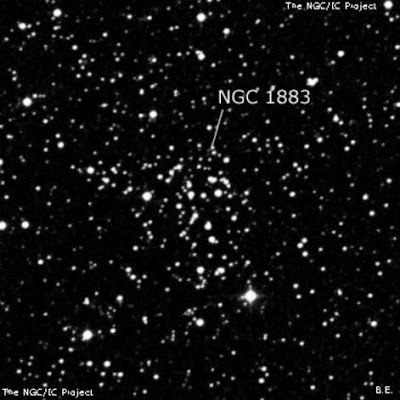When I set out for a night of
deep sky observing, I have a list of objects on my clipboard that I hope to
locate, write about, and sketch. In a future article I will explain how I
go about creating and arranging my lists, and my reasons for doing so.
Readers of this column already know that I am seeking all of the NGC objects
visible from northern locations, and my deep sky travels take me even further
beyond that virtually unconquerable catalogue. However, it is what I do
at the end of an observing session, or if I need a break from a series of very
faint objects I am hunting, that I wish to discuss this month.
At the end of the night’s work I like to choose at least one
bright object previously logged. After
viewing it for a time, I then undertake a little journey into the surrounding
skyscape. So let's begin with M
103, a distant open cluster in Cassiopeia and the last entry by Messier
into his famous catalogue. I
first observed it in August of 1978,
using the Edmund 8” in northern Ontario.
“Another fine cluster, resolving to the
center stopped down to 4” of aperture and using 36x. Averted vision helps resolution.
At 6” of aperture stars resolve very well at this low power, while the
full 8’’ of aperture begins to show splendid star colours in the brighter
members, some of which actually overlay the cluster, rather than belong to
it. At 56x and 4” of aperture the group
was triangular in shape, and quite fine to view. Views were much improved at 6”, especially at 72x and 112x. The member stars that were so very dim at
low power were now much brighter, and a further group of very dim stars began
to faintly resolve beyond them. At 8”
and 169x M 103 becomes quite large and bright, though not as rich as oc 457 or
Messier 52. 338x showed the central
area well. Double star Struve 131 sits
as a beautiful foreground object amidst the cluster.”
I observed it again in October,
2013 from Hallam Observatory with my 12” scope.
“On
a really clear, very dark October night, M103 is not an object to hurry over,
especially with a 12” scope. Perhaps
not as instantly likable as M 52, nor with as many stars, this open cluster is
still quite rich and beautiful to observe.
Lovely even at 60x, there is a generous amount of brighter stars. These are led by a yellow star on one end,
an orange one near the center, and a fine triple star on the side opposite the
yellow star. The cluster remains bright
even up to 200x, where over 40 stars can now be counted. The cluster is pretty dense, but don’t be
put off; even a 6” scope shows the group well.
Don’t be afraid to use high magnification.”
https://cassiopeiaconstellatiom.weebly.com/messier-103-ngc-581.html
After taking my time observing
the bright object (often chosen on a whim), I begin to explore the immediate
surrounding area. It helps to know your
four directions before beginning, but is not essential. With a Dob, allow the object to move across
the field of view. Where it exits is
West (or preceding). North is 90
degrees counter-clockwise. Let’s begin
by heading north. Move the field so
that the cluster is just out of view.
Return, and then go north a little beyond your last journey, trying to
use guide stars to find your way. In
Cassiopeia, one does not travel far before encountering something of interest;
a double star, a coloured star, an interesting asterism, or just a rich field
of stars. Now travel south, going
slowly and looking carefully about as you go.
Go as far as you can without losing your way back to home base, namely M
103. East and West are next. This is not an exercise in finding your way
back home, but rather in trying to discover something that perhaps no one else
has really noted before. Go slowly, and
you are guaranteed to have a rewarding journey. Once the four directions have been mastered, try moving on the
diagonals, until you have covered a reasonable area surrounding the main
object. I am not giving away any of my
secret observing discoveries in this area, but I have a small treasure trove
that I like to revisit now from time to time.
Observers are only limited by their patience and their observing
skills. Training oneself to look at
everything in a field of view, especially at low power, is a skill that can be
developed with practice. It you become
bored with the activity, don’t blame the stars! 15 minutes of slow and careful exploring will almost always prove
rewarding.
Though I used M 103 for my
little sample excursion of wandering through the stars, any bright object can
be used; another Messier object, an NGC one, a bright star or double—the only
restriction is your own imagination. I
like using this observing method—the first of three methods I will discuss in
this column—to de-stress and simply enjoy a beautiful and practically limitless
collection of relatively unknown dark sky territory. Keep notes if you wish; I usually just go for the ride. No atlas or prepared notes are needed for
this method of observing, just the ability to start somewhere with a bright
deep sky object to use as a center point.
In this way, if you do find something interesting it can always be found
again. Enjoy the Autumn skies, and may
they be clear ones!
M 103 (NGC 581): Size
6’; Mag. 7.4; Brightest star mag.
9. Approx. 40 stars at high power with
12” scope.
Mapman Mike
Mapman Mike












